我从乔布斯身上学到什么,纪念乔布斯
乔布斯带给我的思考和启发
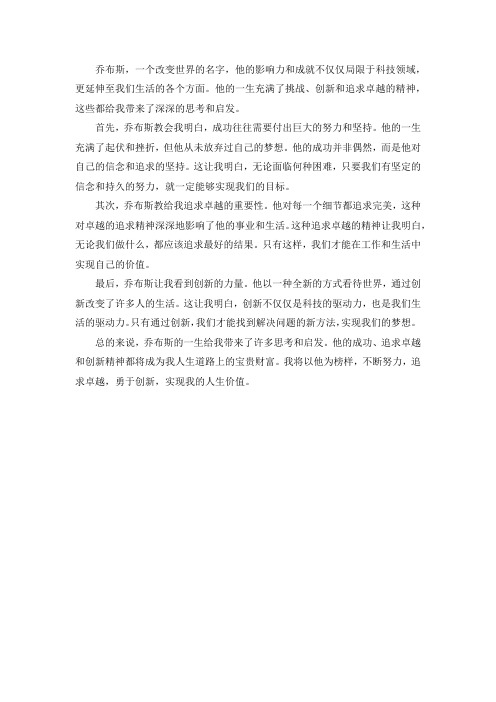
乔布斯,一个改变世界的名字,他的影响力和成就不仅仅局限于科技领域,更延伸至我们生活的各个方面。
他的一生充满了挑战、创新和追求卓越的精神,这些都给我带来了深深的思考和启发。
首先,乔布斯教会我明白,成功往往需要付出巨大的努力和坚持。
他的一生充满了起伏和挫折,但他从未放弃过自己的梦想。
他的成功并非偶然,而是他对自己的信念和追求的坚持。
这让我明白,无论面临何种困难,只要我们有坚定的信念和持久的努力,就一定能够实现我们的目标。
其次,乔布斯教给我追求卓越的重要性。
他对每一个细节都追求完美,这种对卓越的追求精神深深地影响了他的事业和生活。
这种追求卓越的精神让我明白,无论我们做什么,都应该追求最好的结果。
只有这样,我们才能在工作和生活中实现自己的价值。
最后,乔布斯让我看到创新的力量。
他以一种全新的方式看待世界,通过创新改变了许多人的生活。
这让我明白,创新不仅仅是科技的驱动力,也是我们生活的驱动力。
只有通过创新,我们才能找到解决问题的新方法,实现我们的梦想。
总的来说,乔布斯的一生给我带来了许多思考和启发。
他的成功、追求卓越和创新精神都将成为我人生道路上的宝贵财富。
我将以他为榜样,不断努力,追求卓越,勇于创新,实现我的人生价值。
学习乔布斯心得体会

学习乔布斯心得体会乔布斯是现代科技界的传奇人物之一,他对于创新、领导力和设计的贡献无可置疑。
以下是我从研究乔布斯的经历中总结出的一些心得体会:激发创新思维乔布斯一直强调创新对于成功的重要性。
他鼓励团队成员勇于尝试新事物,挑战现有的惯例。
通过激发创新思维,我们能够找到独特的解决方案和创造出具有竞争力的产品。
专注于用户体验乔布斯致力于设计和提供优秀的用户体验。
他相信,只有通过为用户创造出色的产品体验,才能赢得用户的青睐和忠诚。
因此,在我工作中,我始终将用户体验放在首位,力求提供给用户最佳的产品和服务。
忍耐和决心乔布斯的成功并非一帆风顺,他也经历过许多挫折和失败。
然而,他从未放弃,总是保持着忍耐和决心去追求自己的目标。
这种坚持和毅力让他能够克服困难,并最终取得了非凡的成就。
在我日常工作中,我也会时刻铭记这一点,面对困难时保持积极的心态,并持续努力追求自己的目标。
以简为美乔布斯的设计理念中最为著名的就是"以简为美"。
他强调简洁而精致的设计,崇尚将复杂的产品变得易于使用和理解。
在我的工作中,我也会借鉴这一理念,力争提供简单而高效的解决方案,让用户能够轻松应对复杂的问题。
激发团队合作乔布斯在领导团队时非常注重激励和鼓舞团队成员。
他鼓励成员们追求卓越,相信集体的力量,促进团队合作。
在我工作中,我也会努力激发团队成员的潜力,倡导良好的合作氛围,共同追求团队目标。
结语研究乔布斯的心得体会,对于我个人和职业发展都有着重要的意义。
通过激发创新思维,专注于用户体验,保持忍耐和决心,追求简洁和高效的解决方案,并激发团队合作精神,我相信我能够在职业道路上取得更大的成就。
乔布斯教导我们要勇于创新,相信自己的能力,不断追求卓越,并将这些价值观应用于生活和工作中。
> 注意:以上内容仅为个人学习和总结,不是乔布斯的原话。
生涯楷模的品质、事迹所带给你的思考和启发

生涯楷模的品质、事迹所带给你的思考和启发我的生涯楷模是乔布斯。
作为苹果公司的创始人和CEO,乔布斯以其卓越的领导才能、创新的思维方式和刻苦的努力工作而闻名于世。
他的品质和事迹给我带来了深刻的思考和启发,让我认识到成功的真谛和个人成长的重要性。
在以下的文章中,我将详细探讨乔布斯的品质、事迹以及对我的影响。
首先,乔布斯的创新精神是我最喜欢的他的品质之一。
他不仅仅创造了卓越的产品,如iPhone和iMac,而且还改变了许多行业的游戏规则。
乔布斯在技术和设计领域的独特眼光,使他能够看到普通人无法看到的机会和潜力。
他始终在追求卓越和完美,并不断挑战传统的思维方式。
这激励我不仅要追求卓越,而且要有敢于创新和突破的精神。
其次,乔布斯在面对挫折和失败时展现出的坚持不懈和毅力也是我所钦佩的品质之一。
尽管乔布斯在苹果公司被免职的时候遭受了巨大的打击,但他并没有放弃,而是继续努力并最终重返领导岗位。
他的决心和毅力使我相信,成功不仅仅取决于天赋和运气,更重要的是永不放弃的意志和持续的努力。
乔布斯的经历启发我在面对挫折时要保持乐观,坚持追求我的目标。
此外,乔布斯对于用户体验和细节的关注也给我留下了深刻的印象。
他相信产品的设计和用户体验是成功的关键。
他注重每一个细节,追求极致的完美。
这让我认识到,成功的企业需要始终关注用户的需求和体验,并努力提供优质的产品和服务。
乔布斯的追求卓越的态度激励着我在我所从事的工作中注重细节和用户体验,努力提供更好的产品和服务。
乔布斯的领导才能也给予我很多启发。
他不仅是一个出色的领导者,而且是一个激励他人的领导者。
他能够激发员工的潜力,让他们相信自己的能力,并追求更高的目标。
他的激情和信念使他成为一个激励他人的先锋,使团队不断向前发展。
乔布斯的领导风格让我明白到,作为一个领导者,不仅要有明确的目标和远见,还要能够激励和赋予团队成员信心。
这使我更加注意发展我的领导能力,以成为一个优秀的领导者。
最后,乔布斯的成功故事给了我巨大的启发。
史蒂夫《乔布斯传》读后感

史蒂夫《乔布斯传》读后感•相关推荐史蒂夫《乔布斯传》优秀读后感(通用11篇)细细品味一本名著后,大家心中一定有不少感悟,需要写一篇读后感好好地作记录了。
那要怎么写好读后感呢?以下是小编精心整理的史蒂夫《乔布斯传》优秀读后感(通用11篇),希望能够帮助到大家。
史蒂夫《乔布斯传》读后感1去年爸爸从网上买了一整套名人传记,其中其中一本是乔布斯传。
他讲述了乔布斯光芒四射而又短暂的一生,并且客观评价了乔布斯,呈现给了读者一个真正的乔布斯。
乔布斯,是一个美国式的英雄,几逢起伏,但依然屹立不倒,我敬佩不已。
乔布斯是苹果公司的创始人,被大家称为苹果之父那时的人们被本无法想到这,这一个随口乱起名的一个小公司到今已成为了一个无人不知无人不晓的企业,因此我一直对他神往已久充满了崇拜,今年寒假我再一次细细的读了一遍《乔布斯传》。
原来我对乔布斯了解的少之又少,读后深为之痴迷,我感到他真是一个不可思议的人,一个改变了世界的人,虽然他的人生之旅是短的但足以许多活着的人汗颜……他拥有并不完美的童年,但他的养父信守承话,为了去乔不斯满意的大学,甚至不惜搬家换工作,而乔布斯是一个为梦想执着的人,他一生的拼搏用一句名言来说就是“活着就是为了改变世界”为了实现这个目标他不惜放弃大学的学业,即使在他最困难的时候,被自己创办的苹果抛弃,也从来放弃过,最终在那崇尚创新的机会,他实观了自己的梦想,他与他的团队正是美国了人全人类所追求的“创新精神”的代名词,从某种意义上说,乔布斯的成功也许是美国的人性自由个性化教育及创新精神的完美结合。
衷心希望我的中国也能拥有一个自已的“乔布斯”,能够拥有一批有梦想,有创新精神的企业家队伍,以“活着就是为了改变世界”的魄力,振我中华之雄风。
我想要实现这些需要我们改变的太多了死板的教育方式和纯净的创业环境以及正确的财富观……也许不是一代努力可以做到的,以我做起吧!史蒂夫《乔布斯传》读后感2说到乔布斯,可以算是家喻户晓,说他改变了这个世界也不为过,他改变了整个数码行业,开辟了一个新时代。
《史蒂夫·乔布斯传》读后感

《史蒂夫·乔布斯传》读后感•相关推荐《史蒂夫·乔布斯传》读后感(精选6篇)读完一本书以后,相信大家都有很多值得分享的东西,是时候写一篇读后感好好记录一下了。
但是读后感有什么要求呢?下面是小编精心整理的《史蒂夫·乔布斯传》读后感(精选6篇),希望对大家有所帮助。
《史蒂夫·乔布斯传》读后感1对苹果的用户而言,乔布斯无疑是一个伟大的教主,哪怕你不是苹果的用户,你也不能不承认,乔布斯改变了世界,这是一个伟大而天才的人物。
而沃尔特·艾萨克森所著的这本《史蒂夫·乔布斯传》,是乔布斯唯一授权的官方传记。
为了这本传记,艾萨克森与乔布斯进行了40多次面对面交流,直到乔布斯生命最后的日子,除了医生和家人之外,他是乔布斯亲自见的几个人之一。
沃尔特·艾萨克森在传记中并没有将乔布斯作为神来膜拜,相反,他为我们展现个是一个立体真实全面的乔布斯。
作者对于乔布斯小时候和少年时代的事情写的特别仔细,希望告诉我们,乔布斯不是一天练成的,而是从小形成的独特性格。
乔布斯的成长颇有亮点,从小被亲生父母抛弃,被养父母呵护备至,超出自己经济能力的把他送到了俄勒冈州波特兰里德学院,而他却在一个学期之后退了学(但之后他开始去“蹭”那些感兴趣的课程),他吸毒(年轻时候很多人都会尝试毒品)、印度之旅(旅行时美国人了解世界的途径之一,建立了自己的信仰)、参禅(学会让自己的心灵平静)——这些看起来很cool的经历,雅皮士的作风,都为他的人生增添了些许色彩,让整个故事更加传奇。
但在他年轻不羁的生活轨迹中我们可以看到,他并不是一个颓废青年,相反,凭借自己的兴趣和热情,在知识和思想上都进行了学习和提高,这为他今后的成功奠定了坚实的基础。
乔布斯最让人钦佩的一点,是学文科(哲学+书法)的来干工程师的活,还取得了巨大的成就!他改变了六大产业:一是个人电脑,开创了个人电脑时代;二是动画电影,他带领皮克斯在动画领域挑战迪斯尼,并带领了动画电影的进入新领域;三是音乐,ipod的问世改变了人们收听音乐的方式,改变了音乐行业的发展方向;四是个人电话,iphone横空出世,带给人们极大的震撼,改变了人们对手机的概念;五是平板电脑ipad的发布,使苹果公司达到了空前的高度;六是数字出版业。
史蒂夫乔布斯传读后感

史蒂夫乔布斯传读后感史蒂夫乔布斯传读后感(通用20篇)当阅读完一本名著后,相信大家都增长了不少见闻,是时候抽出时间写写读后感了。
为了让您不再为写读后感头疼,下面是小编为大家收集的史蒂夫乔布斯传读后感,希望对大家有所帮助。
史蒂夫乔布斯传读后感篇1说到乔布斯,自然会使人想起那个被咬了一口的苹果标志。
他带来的ipod、ipad、iphone等各种电子产品,已成为当今时代潮流主线。
乔布斯,一个平凡而又伟大的人。
他既是一个好丈夫、好名父亲,又是一位对20世纪的it业有着巨大贡献的人。
乔布斯的成功并不是一帆风顺的,他的一生历经坎坷。
他曾经被自己一手创造,花尽心血的苹果公司辞去,但是,在这种危难关头,乔布斯从未放弃过。
他在离开苹果公司后不久,又立马创办了“next”电脑公司,继续他的事业之旅。
一年后,他又成立了独立公司皮克斯动画工作室。
在之后十年,该公司成为了众所周知的3d电影公司,并推出了全球首部全3d立体动画电影----《玩具总动员》。
从乔布斯的这些经历中,我们可感受到他在遇到挫折时,在人生的低谷中,不气馁,不放弃自我的精神。
使我知道,只有有坚定信心向前走去,不放弃,吸取教训,就可以使人生变得更加辉煌。
我印象最深的是乔布斯在创立苹果公司前后敢于创新,不断创造新产品的片段。
乔布斯与他的朋友沃兹仅用几个星期谅装好了一台电脑。
不久后,乔布斯又相继推出了ipod、lisa电脑等各种新产品。
我不禁为之惊讶,乔布斯怎么能用这么快的速度推出一个个使人看一眼就喜欢上的新产品!正是他那勇于创新的精神使苹果公司再次崛起;使皮克斯公司推出了全球首部全3d立体动画电影;使苹果公司的辉煌成为一个奇迹……现在我们的学习中也需要这种创新精神,在课题研究中,唯有创新精神,才会使我们克服研究中遇到的一个个难关,也使调查研究不再老生常谈,同时可培养我们的发散性思维与非线性思维……从乔布斯身上,我们可以学到很多,他成长道路上的点滴,都是财富。
乔布斯传读后心得

乔布斯传读后心得(经典版)编制人:__________________审核人:__________________审批人:__________________编制单位:__________________编制时间:____年____月____日序言下载提示:该文档是本店铺精心编制而成的,希望大家下载后,能够帮助大家解决实际问题。
文档下载后可定制修改,请根据实际需要进行调整和使用,谢谢!并且,本店铺为大家提供各种类型的经典范文,如心得体会、策划方案、规章制度、合同协议、条据文书、应急预案、职业规划、教学资料、作文大全、其他范文等等,想了解不同范文格式和写法,敬请关注!Download tips: This document is carefully compiled by this editor. I hope that after you download it, it can help you solve practical problems. The document can be customized and modified after downloading, please adjust and use it according to actual needs, thank you!Moreover, our store provides various types of classic sample essays, such as insights, planning plans, rules and regulations, contract agreements, documentary evidence, emergency plans, career planning, teaching materials, complete essays, and other sample essays. If you want to learn about different sample formats and writing methods, please pay attention!乔布斯传读后心得乔布斯传读后心得【精选5篇】乔布斯的管理,说他什么事情都亲力亲为,都要参与是误解。
《乔布斯传》读后感(三篇)
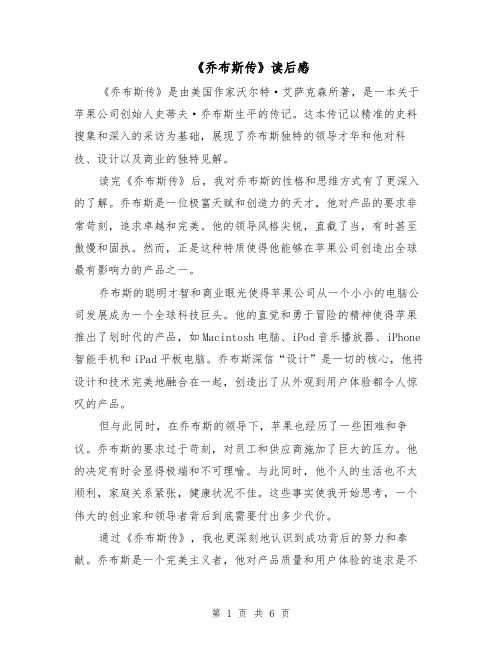
《乔布斯传》读后感《乔布斯传》是由美国作家沃尔特·艾萨克森所著,是一本关于苹果公司创始人史蒂夫·乔布斯生平的传记。
这本传记以精准的史料搜集和深入的采访为基础,展现了乔布斯独特的领导才华和他对科技、设计以及商业的独特见解。
读完《乔布斯传》后,我对乔布斯的性格和思维方式有了更深入的了解。
乔布斯是一位极富天赋和创造力的天才,他对产品的要求非常苛刻,追求卓越和完美。
他的领导风格尖锐,直截了当,有时甚至傲慢和固执。
然而,正是这种特质使得他能够在苹果公司创造出全球最有影响力的产品之一。
乔布斯的聪明才智和商业眼光使得苹果公司从一个小小的电脑公司发展成为一个全球科技巨头。
他的直觉和勇于冒险的精神使得苹果推出了划时代的产品,如Macintosh电脑、iPod音乐播放器、iPhone 智能手机和iPad平板电脑。
乔布斯深信“设计”是一切的核心,他将设计和技术完美地融合在一起,创造出了从外观到用户体验都令人惊叹的产品。
但与此同时,在乔布斯的领导下,苹果也经历了一些困难和争议。
乔布斯的要求过于苛刻,对员工和供应商施加了巨大的压力。
他的决定有时会显得极端和不可理喻。
与此同时,他个人的生活也不太顺利,家庭关系紧张,健康状况不佳。
这些事实使我开始思考,一个伟大的创业家和领导者背后到底需要付出多少代价。
通过《乔布斯传》,我也更深刻地认识到成功背后的努力和奉献。
乔布斯是一个完美主义者,他对产品质量和用户体验的追求是不断推动他前进的动力。
他不仅是一个有远见的商业家,还是一个极具想象力的艺术家。
他的思维方式非常独特,他相信创意和创新的力量,相信人们渴望拥有美丽和易用的产品。
《乔布斯传》对于我个人来说,不仅是一本关于乔布斯的传记,更是一本关于领导力和创新的教材。
乔布斯的成功并非偶然,他在商界的影响力和对科技界的贡献都是靠坚定的信念和毅力取得的。
他坚信自己可以改变世界,并通过不断地努力和创新来实现这个目标。
读完《乔布斯传》,我对自己的职业规划和目标也有了更明确的认识。
《乔布斯传》优秀读后感(精选25篇)

《乔布斯传》优秀读后感《乔布斯传》优秀读后感(精选25篇)当认真看完一本名著后,你有什么领悟呢?这时候,最关键的读后感怎么能落下!想必许多人都在为如何写好读后感而烦恼吧,下面是小编精心整理的《乔布斯传》优秀读后感,仅供参考,欢迎大家阅读。
《乔布斯传》优秀读后感篇1刚在微信读书看完了乔布斯传,想说的东西很多,但是真的在屏幕前却感觉啥也写不出来,那就写到哪算哪吧。
这本书是从乔布斯的童年开始写的,他一出生就被亲生母亲遗弃,但是幸而收养他的夫妻给了他温暖,不过他的性格也是有些孤僻与不合群,也许这就是天才与众不同之处吧。
纵观他的一生,其实他也没什么变化,尊从少即是多,极简的态度体现在他的人生和产品中,一直以来他都是依靠自己,倔强地活着,倔强地用封闭的方式打造完美的产品,从一而终,而这也是给我带来最多感动的地方。
我们普通人,善于妥协,不敢表达自己的真实想法,很虚伪,讲人情,而他从不妥协,善于打破常规,发现错误马上就要改,无论一个产品打磨了多久,即使在最后时刻发现了不完美的地方,就推倒重来,我敢说正常人不会这样做,他不能忍受一丁点不完美,他是一位真正的艺术大家。
以前看网文小说,某些主角重生过去,收购了苹果,把乔布斯踢出苹果,然后用自己未来的眼光发展苹果,以前我觉得没问题,后来随着我对真实世界的理解,我认为这是不可能的,没有乔布斯追求完美的个性,没有他追求卓越的目标,苹果不会成为伟大的传世公司,一个人的性格决定了他的格局,这不是靠简单的模仿能成就的,以前这种网文我觉得很有意思,但是现在却是笑而不语,作者并不了解真实世界,那只是一个虚幻的地方。
在这本书中,我看到了坚持自己观念的难度,周围的环境都说你是错的,只有你自己在坚持,无形的压力逼迫你投降,我看到了乔布斯的痛哭,崩溃,但是他一直没有放弃,依旧是特立独行,冲破牢笼,而在现实生活中,我们被逼着做了很多自己并不是真正想做的事,比如做一份稳定的工作,比如快点结婚生子,比如买房,不是说这些事有问题,有问题的是你自己是否想这样,有没有得可以自由选择,而普通人没有,只能随波逐流,在什么时间就做什么事情。
2024年乔布斯传心得体会
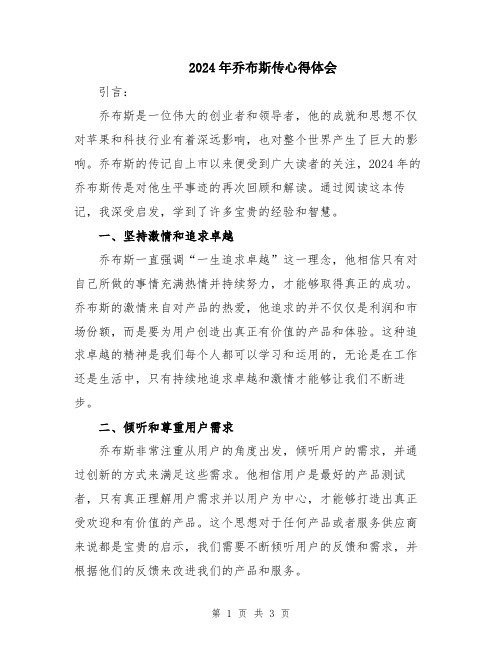
2024年乔布斯传心得体会引言:乔布斯是一位伟大的创业者和领导者,他的成就和思想不仅对苹果和科技行业有着深远影响,也对整个世界产生了巨大的影响。
乔布斯的传记自上市以来便受到广大读者的关注,2024年的乔布斯传是对他生平事迹的再次回顾和解读。
通过阅读这本传记,我深受启发,学到了许多宝贵的经验和智慧。
一、坚持激情和追求卓越乔布斯一直强调“一生追求卓越”这一理念,他相信只有对自己所做的事情充满热情并持续努力,才能够取得真正的成功。
乔布斯的激情来自对产品的热爱,他追求的并不仅仅是利润和市场份额,而是要为用户创造出真正有价值的产品和体验。
这种追求卓越的精神是我们每个人都可以学习和运用的,无论是在工作还是生活中,只有持续地追求卓越和激情才能够让我们不断进步。
二、倾听和尊重用户需求乔布斯非常注重从用户的角度出发,倾听用户的需求,并通过创新的方式来满足这些需求。
他相信用户是最好的产品测试者,只有真正理解用户需求并以用户为中心,才能够打造出真正受欢迎和有价值的产品。
这个思想对于任何产品或者服务供应商来说都是宝贵的启示,我们需要不断倾听用户的反馈和需求,并根据他们的反馈来改进我们的产品和服务。
三、坚持原创和创新乔布斯一直强调原创和创新的重要性。
他相信只有通过创新才能够在激烈的市场竞争中取得领先地位。
乔布斯在苹果公司的发展过程中始终坚持原创和创新,不断推出各个领域的创新性产品。
乔布斯的思想告诉我们,作为领军人物,我们需要具备创新的思维和勇气,不断探索新的可能性,才能够获得成功。
四、全力以赴和专注乔布斯非常强调全力以赴和专注的重要性。
他相信只有全身心地去做一件事并将其做到最好,才能够取得真正的成功。
乔布斯在苹果公司的发展过程中总是全情投入,一心一意地为苹果的产品和用户体验着想。
他的专注和全力以赴精神让我深受启发,我意识到只有当我们全身心地投入并且专注于一件事情时,才能够取得真正的成果。
五、迎接失败和挫折乔布斯的成功之路并不平坦,他也遭遇了许多挫折和失败。
乔布斯传读后感

乔布斯传读后感乔布斯传读后感 (10篇)认真读完一本名著后,你有什么领悟呢?此时需要认真地做好记录,写写读后感了。
想必许多人都在为如何写好读后感而烦恼吧,以下是小编整理的乔布斯传读后感,希望能够帮助到大家。
乔布斯传读后感 1近段时间,四位姐妹又读完了《乔布斯传》这本英文书。
对乔布斯的了解,之前我只知道他是苹果公司的创始人之一,他公司的产品iPad,iPhone正风行世界,他是著名的亿万富翁。
通过对这本书的学习,对他有了进一步的了解。
他是革命的先驱者,他改变了电脑行业,手机行业,电影行业以及音乐行业等。
为什么他能如此成功?个人觉得他主要有几个很好的特质:1、有远见卓识在苹果电脑公司的发展初期,当乔布斯和几个苹果同事参观施乐公司的时候,他就看见电脑的未来发展,并且坚持把它商业化。
40年来也一直坚持朝着这个方向发展。
乔布斯的远见卓识还表现在:当电影导演乔治卢卡带他看看他旗下的电脑动画,这个电脑动画公司当时正在放盘出售,乔布斯看到电脑动画很原始和粗糙,这令他非常的震惊。
因为他看到了机会。
这就是他的远见卓识。
于是他花1000万美元买入皮克斯的动画制作室。
虽然发展的过程中也有波折,但最后还是取得巨大的成功。
2、完美主义当他发现产品有一点点的瘕疵,他决不放过。
就像在书中提到的:当他另组的团队在开发Macintosh时,他听到电脑发出一点点的噪声,后来员工告诉他那个噪声是风扇发出来的,乔布斯当时就要求员工要想办法解决它。
为了解决声音问题,他推迟6个月发布新产品。
关于皮克斯动画电影,他同样要求尽善尽美。
乔布斯邀请他的朋友到他家去看他的新爱好——皮克斯动画电影。
他的朋友说在这部电影发布前他不知道看了多少次。
可想而知,乔布斯对皮克斯动画进行多次的修改。
直到他自已满意为止。
由此可见,他对细节的完美执着的追求。
3、不断的创造力纵观乔布斯职业生涯40年左右时间,他创造出许多的新产品。
有成功也有失败。
在推出失败的Macintosh和Lisa电脑后,乔布斯经历一段惨痛的经历。
人物传记之乔布斯传读后感【七篇】写范文网
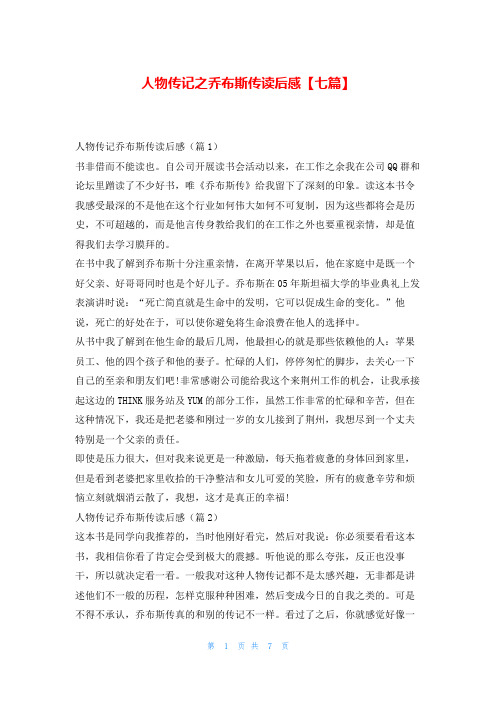
人物传记之乔布斯传读后感【七篇】人物传记乔布斯传读后感(篇1)书非借而不能读也。
自公司开展读书会活动以来,在工作之余我在公司QQ群和论坛里蹭读了不少好书,唯《乔布斯传》给我留下了深刻的印象。
读这本书令我感受最深的不是他在这个行业如何伟大如何不可复制,因为这些都将会是历史,不可超越的,而是他言传身教给我们的在工作之外也要重视亲情,却是值得我们去学习膜拜的。
在书中我了解到乔布斯十分注重亲情,在离开苹果以后,他在家庭中是既一个好父亲、好哥哥同时也是个好儿子。
乔布斯在05年斯坦福大学的毕业典礼上发表演讲时说:“死亡简直就是生命中的发明,它可以促成生命的变化。
”他说,死亡的好处在于,可以使你避免将生命浪费在他人的选择中。
从书中我了解到在他生命的最后几周,他最担心的就是那些依赖他的人:苹果员工、他的四个孩子和他的妻子。
忙碌的人们,停停匆忙的脚步,去关心一下自己的至亲和朋友们吧!非常感谢公司能给我这个来荆州工作的机会,让我承接起这边的THINK服务站及YUM的部分工作,虽然工作非常的忙碌和辛苦,但在这种情况下,我还是把老婆和刚过一岁的女儿接到了荆州,我想尽到一个丈夫特别是一个父亲的责任。
即使是压力很大,但对我来说更是一种激励,每天拖着疲惫的身体回到家里,但是看到老婆把家里收拾的干净整洁和女儿可爱的笑脸,所有的疲惫辛劳和烦恼立刻就烟消云散了,我想,这才是真正的幸福!人物传记乔布斯传读后感(篇2)这本书是同学向我推荐的,当时他刚好看完,然后对我说:你必须要看看这本书,我相信你看了肯定会受到极大的震撼。
听他说的那么夸张,反正也没事干,所以就决定看一看。
一般我对这种人物传记都不是太感兴趣,无非都是讲述他们不一般的历程,怎样克服种种困难,然后变成今日的自我之类的。
可是不得不承认,乔布斯传真的和别的传记不一样。
看过了之后,你就感觉好像一下真正的经历了什么异常的经历一样。
他的很多理论和经验真的让我受用一生。
如今乔布斯已经离我们而去,可是他所创造的苹果和人生理念真的算得上是一种无形的巨大财富,供我们这些人学习。
有关乔布斯的读后感样本(3篇)
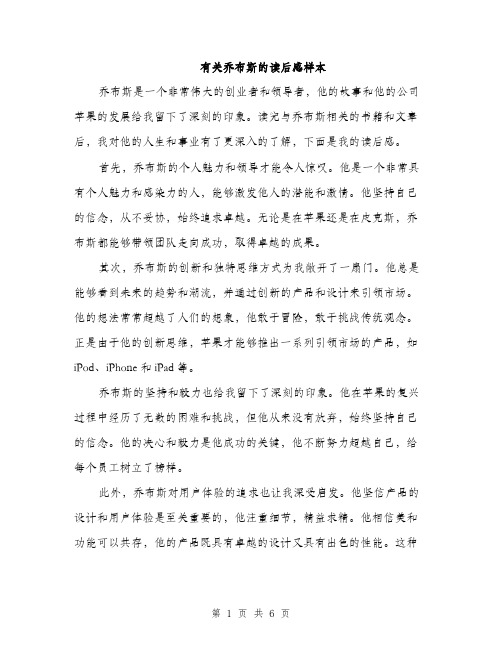
有关乔布斯的读后感样本乔布斯是一个非常伟大的创业者和领导者,他的故事和他的公司苹果的发展给我留下了深刻的印象。
读完与乔布斯相关的书籍和文章后,我对他的人生和事业有了更深入的了解,下面是我的读后感。
首先,乔布斯的个人魅力和领导才能令人惊叹。
他是一个非常具有个人魅力和感染力的人,能够激发他人的潜能和激情。
他坚持自己的信念,从不妥协,始终追求卓越。
无论是在苹果还是在皮克斯,乔布斯都能够带领团队走向成功,取得卓越的成果。
其次,乔布斯的创新和独特思维方式为我敞开了一扇门。
他总是能够看到未来的趋势和潮流,并通过创新的产品和设计来引领市场。
他的想法常常超越了人们的想象,他敢于冒险,敢于挑战传统观念。
正是由于他的创新思维,苹果才能够推出一系列引领市场的产品,如iPod、iPhone和iPad等。
乔布斯的坚持和毅力也给我留下了深刻的印象。
他在苹果的复兴过程中经历了无数的困难和挑战,但他从来没有放弃,始终坚持自己的信念。
他的决心和毅力是他成功的关键,他不断努力超越自己,给每个员工树立了榜样。
此外,乔布斯对用户体验的追求也让我深受启发。
他坚信产品的设计和用户体验是至关重要的,他注重细节,精益求精。
他相信美和功能可以共存,他的产品既具有卓越的设计又具有出色的性能。
这种对用户体验的追求使苹果产品成为市场的领导者,并赢得了全球用户的喜爱。
最后,乔布斯的故事也给我带来了一些反思。
他的成功不是一蹴而就的,背后有着无数的汗水和努力。
他经历了挫折和失败,但从来没有放弃自己的梦想。
他通过不懈的努力和持之以恒的精神,最终实现了自己的目标。
乔布斯的故事告诉我要坚持追求梦想,无论遇到什么困难和挑战,都要勇敢地面对并且不断努力。
总的来说,乔布斯是一个非常伟大的领袖和创业者,他的故事和他的公司苹果的发展给我留下了深刻的印象。
他的个人魅力、创新思维、坚持不懈和对用户体验的追求都让我深受启发。
读完乔布斯的相关书籍和文章后,我对他的故事和事业有了更深入的了解,也更加敬佩他的才华和成就。
我们能从乔布斯身上学到的六条经验

我们能从乔布斯身上学到的六条经验想要追踪史蒂夫?乔布斯(Steve Jobs)的业绩并不是一件难事。
他的业绩都是巨大的,公开的,尤其是在技术方面的业绩相当持久。
更微妙也更有趣的是,如果我们努力学习,我们会从他的成功经验中学到很多。
1. 风格就是内容从一开始乔布斯和苹果就对他们的风格深信不疑:字体、图形、行业设计和市场营销。
这在当时看起来很古怪,在今天看起来依然古怪,这很容易被人们低估。
大多数的组织认为风格是营销的专属职权范围,即使在营销方面也很少有人能在风格方面获得成功。
如今,大多数软件和硬件看起来依然很笨重、丑陋或者说是衍生物。
(Kindle 很丑陋,Fire只是苍白的模仿)。
15年前,我刚开始从事技术工作的时候,风格被人们看做是无足轻重的,如今很多公司里的人们还是这样认为。
那些认为苹果的成功完全来自于盒子内部的内容(确实有几个)的人错过了很明显的一点。
传统智慧将思考分为左脑思维和右脑思维。
左脑主要负责系统的、理性的线性的思考而右脑负责情感和创造性的思考。
乔布斯证明了成功不在重视左脑思考还是右脑思考,而是要将两者相结合。
他接管皮克斯动画工作室(Pixar)就是很好的证明。
新校园计划建三栋独立的大楼:一栋楼是给创造者、一栋楼给生产者,另一栋楼给商务人士。
他坚持将三类人放在同一栋大楼,并且大楼的中心必须是厕所,因为厕所是这三类人可以见面和谈话的地方。
2. 耐心打败速度众所周知苹果产品开发很快,但事实上乔布斯是一个很擅长等待的人。
他在1997年重新回到苹果后,当时苹果在破产的边缘摇摇欲坠,他做了任何一个聪明的CEO都会做的事情:减少产品线(将15个台式机型减少至1个),减少软件和硬件工程师的数量,消除了外围设备,较少库存和零售业务并将大多数制造过程转移到海外。
这一点并不值得炫耀,这是教科书上可以学到的东西。
但在1998年,当Richard Rummelt问乔布下一步打算做什么来改变苹果脆弱的利基地位时,乔布斯有一个大胆的回答:“我会等待下一件大事发生”。
乔布斯读后感范文(精选12篇)

乔布斯读后感范文(精选12篇)看完一本名著后,大家心中一定有很多感想,是时候抽出时间写写读后感了。
那么我们该怎么去写读后感呢?下面是小编整理的乔布斯读后感范文(精选12篇),欢迎阅读,希望大家能够喜欢。
乔布斯读后感1《非凡乔布斯》这一本书是一本讲述乔布斯传奇的一生的故事:从一开始,史蒂夫-乔布斯的命运就注定有一段非同寻常的道路,他一出生就被抛弃,被别人收养。
大学上了一学期便辍学不上,但即使是这样,乔布斯想赚钱的信心也从不动摇,在他二十岁时,与朋友史蒂夫-沃兹尼亚克在父母的车库里创立了苹果公司,很快,变跃升为计算机行业的袖。
他不断的拓展自己的公司,培养其天才,然而,在他的公司迅速成功之后,身为老板的乔布斯却被自己的公司开除了。
全部从零开始,乔布斯却进入他他一生中最富创造力的一个时期:他通过皮克斯动画,Ipod,iphone,在电影,音乐,电话掀起了变革的狂澜。
乔布斯也因此成为了一个家喻户晓的伟人。
这一本书告诉了我:想要获得成功就必须坚持,坚持,再坚持,就像生活在沙漠中的骆驼一样,骆驼的速度很慢,可是,骆驼知道:慢慢地走,总会到的;慢慢的嚼,总会吃饱的,而它正是知道这个道理,所以他才能再漫漫的沙漠中活下来。
乔布斯读后感2国庆期间,我读了美国作家帕特丽夏·拉金的一本书《我是乔布斯》。
这本书给我们讲述了乔布斯一生中最具有代表性的事件。
这本书告诉我们,是否有坚持不懈的毅力是决定创业成败的最重要的因素。
我印象最深的事是:一九七二年,乔布斯要上大学了。
开学六个月后,他花光了父母毕生的积蓄,眼看着就要退学,完不成学业了,但是他并没有放弃,在他的两个好朋友的宿舍借宿,省去了住宿费;如果没有免费睡觉的地方,他就会打一些零工,然后在学校旁租便宜的房间;之后又挣到了吃饭的钱。
乔布斯靠着自己坚持不懈的精神,最终完成了学业。
乔布斯这种坚持不懈的精神一直都在鼓舞着我。
记得前两天,我在做数学作业时,碰到了一道难题,那时爸爸妈妈不在身边,我在草稿纸上画了很多图,列了很多算式,时间一分一秒的过去了,可我还是没有想到解答方法,看看闹钟,已经晚上十点多了。
乔布斯传读后感(3篇)
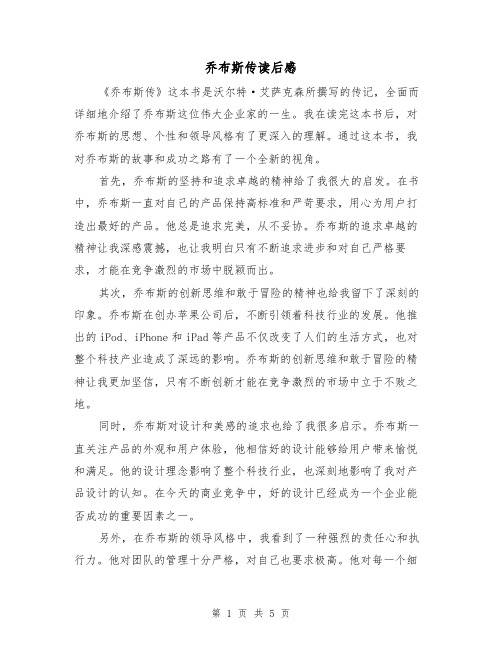
乔布斯传读后感《乔布斯传》这本书是沃尔特·艾萨克森所撰写的传记,全面而详细地介绍了乔布斯这位伟大企业家的一生。
我在读完这本书后,对乔布斯的思想、个性和领导风格有了更深入的理解。
通过这本书,我对乔布斯的故事和成功之路有了一个全新的视角。
首先,乔布斯的坚持和追求卓越的精神给了我很大的启发。
在书中,乔布斯一直对自己的产品保持高标准和严苛要求,用心为用户打造出最好的产品。
他总是追求完美,从不妥协。
乔布斯的追求卓越的精神让我深感震撼,也让我明白只有不断追求进步和对自己严格要求,才能在竞争激烈的市场中脱颖而出。
其次,乔布斯的创新思维和敢于冒险的精神也给我留下了深刻的印象。
乔布斯在创办苹果公司后,不断引领着科技行业的发展。
他推出的iPod、iPhone和iPad等产品不仅改变了人们的生活方式,也对整个科技产业造成了深远的影响。
乔布斯的创新思维和敢于冒险的精神让我更加坚信,只有不断创新才能在竞争激烈的市场中立于不败之地。
同时,乔布斯对设计和美感的追求也给了我很多启示。
乔布斯一直关注产品的外观和用户体验,他相信好的设计能够给用户带来愉悦和满足。
他的设计理念影响了整个科技行业,也深刻地影响了我对产品设计的认知。
在今天的商业竞争中,好的设计已经成为一个企业能否成功的重要因素之一。
另外,在乔布斯的领导风格中,我看到了一种强烈的责任心和执行力。
他对团队的管理十分严格,对自己也要求极高。
他对每一个细节都极为关注,精益求精。
这种强烈的责任心和执行力是推动企业不断前进的关键。
乔布斯相信只有凭借一个优秀的团队和良好的执行力,才能将创意转化为现实。
最后,我被乔布斯对生命的渴望和对工作的热爱深深地感动了。
无论是面对癌症的折磨,还是面对苹果公司的困境,乔布斯都没有放弃,始终坚持自己的信念。
他坚信每一天都应该过得充实而有意义,充满热情地投入到工作中。
乔布斯通过自己的坚持和努力,证明了只要对自己有信心,并为之付出努力,就能够实现自己的目标。
我从乔布斯身上学到了

我从乔布斯身上学到了说乔布斯是改变世界的天才,没有非议,或许只有他自己不这么觉得。
乔布斯既不是硬件工程师,也不是软件程序员,他更不认为自己是一名经理。
他将自己视为科级领导者,尽可能地选出最好的人才,鼓励和刺激他们,并在产品设计上最后拍板。
他凭敏锐的触觉和过人的智慧,勇于变革,不断创新,引领全球资讯科技和电子产品的潮流,把电脑和电子产品变得简约化、平民化,让曾经是昂贵稀罕的电子产品变为现代人生活的一部分。
首先我从他身上学到了谦逊。
果断的抉择,看清自己的道路。
才入大学六个月后看清自己的爱好果断辍学,相信和自己的梦想出发显现出了非凡的,坚持自己的道路,并为之努力终于做出了属于自己的第一台微型个人计算机。
机遇往往垂青努力的人,苹果成立初期生意冷清,一次偶然的机遇乔获得了一个50台电脑整机的订单要一个月交货,那时电脑只能靠乔布斯和同伙亲自手工组装,时间太仓促,任务又繁重,乔布斯和沃兹冒着酷暑,没日没夜地干了起来,为了公司的生存,他们豁出去了。
他们每天几乎都在挥汗如雨、顽强拼搏中度过,每周工作66小时。
终于在第29天他们奇迹般地完成了任务,把50台“苹果”电脑如数交给了订货商。
从而奠定了苹果成功的基础。
汲取失败教训,以更高的起点腾飞。
80年代由于乔布斯经营理念与当时大多数管理人员不同,加上蓝色巨人IBM公司也开始醒悟过来,也推出了个人电脑,抢占大片市场,使得乔布斯新开发出的电脑节节惨败,总经理和董事们便把这一失败归罪于董事长乔布斯,于1985年4月经由董事会决议撤销了他的经营大权。
乔布斯几次想夺回权力均未成功,便在1985年9月17日愤而辞去苹果公司董事长。
96年重回苹果的时候乔布斯个人身价已暴涨逾10亿美元;而相形之下,苹果公司却已濒临绝境。
他带领苹果经过十几年走到了世界科技公司的第一。
创新才是发展的王道,乔布斯重归之后推出了imac,ibook。
重新引导了电子科技市场的发展方向,iphone,ipad,他总能满足世人的胃口,因为创新他成为世界的标榜。
关于读乔布斯传的心得读后感5篇_有关个人读乔布斯传的心得读后感

关于读乔布斯传的心得读后感5篇_有关个人读乔布斯传的心得读后感读完《乔布斯传》,对乔布斯的成长经历感慨万千。
那么关于读乔布斯传的心得读后感该怎么写呢?下面是小编为大家精心整理的关于乔布斯传的读后感优秀范文,欢迎大家阅读。
更多的读乔布斯传读后感请点击下方↓↓↓乔布斯传读后感【1】手触屏Ipad平板电脑,轻松上网的手机Iphone4s,小巧玲珑的音乐播放器这些,是众人皆知的苹果公司的高级产品,而这个天才公司的天才老板就是史蒂夫乔布斯。
乔布斯,一个被父母遗弃的私生子,一个不能忍受六个月大学生活就退学的叛逆者,一个曾经吸食迷幻药、大麻的瘾君子,更是一个不创新就等于死亡的践行者。
说到乔布斯,你可能会羡慕他的财富,也许会惊叹他的事业,同时你也一定会喜欢他带来的iPad和iPhone4s,但重要的不是他的产品、更不不是他的财富,我认为最重要的就是他的创新、他的追求完美他开创产品的过程。
举一个例子,Iphone刚刚问世时,所有人都非常震撼,可乔布斯却不满足,连续推出了Iphone2、Iphone3、Iphone4s正是这种追求上进、不满足现状、追求完美创造了奇迹。
乔布斯经历的坎坷,比你我只会多不会少。
比如乔布斯的朋友斯卡利,之前乔布斯很看好他,但是最后斯斯卡利背叛了乔布斯,竟把公司的原创人乔布斯赶出公司。
乔布斯只好自己又创建了neXT公司。
但与别人不同的是,他毫不畏惧,在内心深处的理想引领下,坚持把每一天都当成生命的最后一天来战斗,以此苛求自己的付出。
这也许才是他最值得我们深思之处。
乔布斯的人生点滴都是财富,从他身上我们能学到很多,酸甜苦辣生活汤是人生道路的点缀,没有它们,世界上之有成功,只有幸运,我们的人生还有价值吗?最低谷、最高峰都是人要经历的,而有想法的人则会重整目标,调整脚步,整装出发;一般人就会停下脚步,满足于现状。
乔布斯对当时的可口可乐公司老板斯卡利说:你想用卖糖水来度过余生,还是想抓住这个机会来改变世界?。
- 1、下载文档前请自行甄别文档内容的完整性,平台不提供额外的编辑、内容补充、找答案等附加服务。
- 2、"仅部分预览"的文档,不可在线预览部分如存在完整性等问题,可反馈申请退款(可完整预览的文档不适用该条件!)。
- 3、如文档侵犯您的权益,请联系客服反馈,我们会尽快为您处理(人工客服工作时间:9:00-18:30)。
What I learned from Steve Jobs我从Steve Jobs身上学到了什么by Guy Kawasaki October 8, 2011 8:33 AM PDTMany people have explained what one can learn from Steve Jobs. But few, if any, of these people have been inside the tent and experienced first hand what it was like to work with him. I don’t want any lessons to be lost or forgotten, so here is my list of the top 12 lessons I learned from Steve Jobs.有很多人都说过曾经在Steve Jobs身上学到了什么。
但只有少数的人能和他一起共事并有和他一起工作的经历。
我不希望有一天忘了这些宝贵的经验,所以我归纳写下了从Steve Jobs学到的12点经验。
1.Experts are cluelessExperts—journalists, analysts, consultants, bankers, and gurus can’t “do” so they“advise.” They can tell you what is wrong with your product, but they cannot make agreat one. They can tell you how to sell something, but they cannot sell it themselves.They can tell you how to create great teams, but they only manage a secretary. Forexample, the experts told us that the two biggest shortcomings of Macintosh in the mid1980s were the lack of a daisy-wheel printer driver and Lotus 1-2-3; another advice gem from the experts was to buy Compaq. Hear what experts say, but don’t always listen tothem.专家是无知的专家—记者,分析师,顾问,银行家和大师们都不可以“做”所以他们“建议”。
他们可以告诉你你的产品有什么错处,但是他们却不能做一个好的。
他们可以教你怎样去卖一个东西,但是他们自己却不能卖。
他们可以告诉你怎样去组织一支好队伍,但是他们只能管理秘书。
例如,有专家告诉我们,在20世纪80年代中期的Macintosh上两个最大的缺点是缺乏打印机驱动程序和Lotus 1-2-3(一种类似EXCEL的程序);另外一位专家建议收购Compaq。
要听专家们说什么,但是不要常常听取他们的意见。
2.Customers cannot tell you what they need“Apple market research” is an oxymoron. The Apple focus group was the righthemisphere of Steve’s brain talking to the left one. If you ask customers what they want, they will tell you, “Better, faster, and cheaper”—that is, better sameness, notrevolutionary change. They can describe their desires only in terms of what they arealready using—around the time of the introduction of Macintosh, all that people said they wanted was a better, faster, and cheaper MS-DOS machine. The richest vein for techstartups is creating the product that you want to use—that’s what Steve and Woz did.客人永远不能告诉你他们需要的是什么“苹果的市场调查”是一个矛盾。
苹果焦点小组像是Steve的右脑向左脑谈话。
如果你问客人他们想要什么,他们会告诉你“更好,更快和更便宜”—那是,更好的同一性而不是革命性的变化。
他们只可以在已经使用的前提下形容他们的愿望-在格的刚推出Macintosh,所有人只说到他们想要更好,更快,更便宜的MS-DOS机器。
靠技术创业就是为人们创造人们想要的产品-那就是Steve和Woz所做的事情。
3.Jump to the next curveBig wins happen when you go beyond better sameness. The best daisy-wheel printer companies were introducing new fonts in more sizes. Apple introduced the next curve: laser printing. Think of ice harvesters, ice factories, and refrigerator companies. Ice 1.0,2.0, and3.0. Are you still harvesting ice during the winter from a frozen pond?跳转到下一阶段当你超出更好的同一性就能得到最大的胜利。
最大的针式打印机公司引进了更多尺寸的新字体。
苹果公司推出了新的技术:镭射打印。
想想切冰机,冰工厂,和冰箱公司的关系。
相对于”冰”的1.0,2.0和3.0版本. 那你现在依然会在冬天结了冰的池塘里砸取冰块吗?4.The biggest challenges beget best workI lived in fear that Steve would tell me that I, or my work, was crap. In public. This fearwas a big challenge. Competing with IBM and then Microsoft was a big challenge.Changing the world was a big challenge. I, and Apple employees before me and after me, did our best work because we had to do our best work to meet the big challenges.最大的挑战能让你做到最好的结果我曾经很害怕Steve会说我或者我的工作是没用的。
尤其是对于外界,这种担心对我是很大挑战。
和IBM,然后微软的竞争是个很大的挑战.改变世界更是个巨大的挑战.面临巨大的挑战,我和我之前或者之后的全体苹果员工竭尽所能地工作。
因为,我们只能把工作做到最好来去面对这些巨大的挑战.5.Design countsSteve drove people nuts with his design demands—some shades of black weren’t black enough. Mere mortals think that black is black, and that a trash can is a trash can. Steve was a perfectionist, and he was right: some people care about design and many people at least sense it. Maybe not everyone, but the important ones.设计方面Steve设计出来的东西会令人发疯—例如:产品黑色深浅达不到要求,或者说不够黑。
其他人认为黑色的就是黑色的,就像一个垃圾桶就是一个垃圾桶,没有太多的区别。
但是Steve是一个完美主义者。
他一直坚持,但他是正确的:在设计方面,绝大部分人只会意识到要做好,但不是全部,只有少部分人真正关心并做到很认真地把事情做好。
The Apple iPhone, officially unveiled at the Macworld trade show on January 9, 2007, was arguably the single most anticipated gadget in the history of the high-tech and consumer electronics industries.(Credit: Declan McCullagh/CNET)2007年1月9日,苹果IPHONE在MACWORLD展会上正式亮相,可以说是在高科技和消费电子行业历史上最值得期待的产品。
6.You can’t go wrong with big graphics and big fontsTake a look at Steve’s slides. The font is 60 points. There’s usually one big screenshot or graphic. Look at other tech speaker’s slides—even the ones who have seen Steve inaction. The font is 8 points, and there are no graphics. So many people say that Steve was the world’s greatest product introduction guy. Don’t you wonder why more people don’t copy his style?大型图片和大的字体是不会错的看看Steve的幻灯片。
